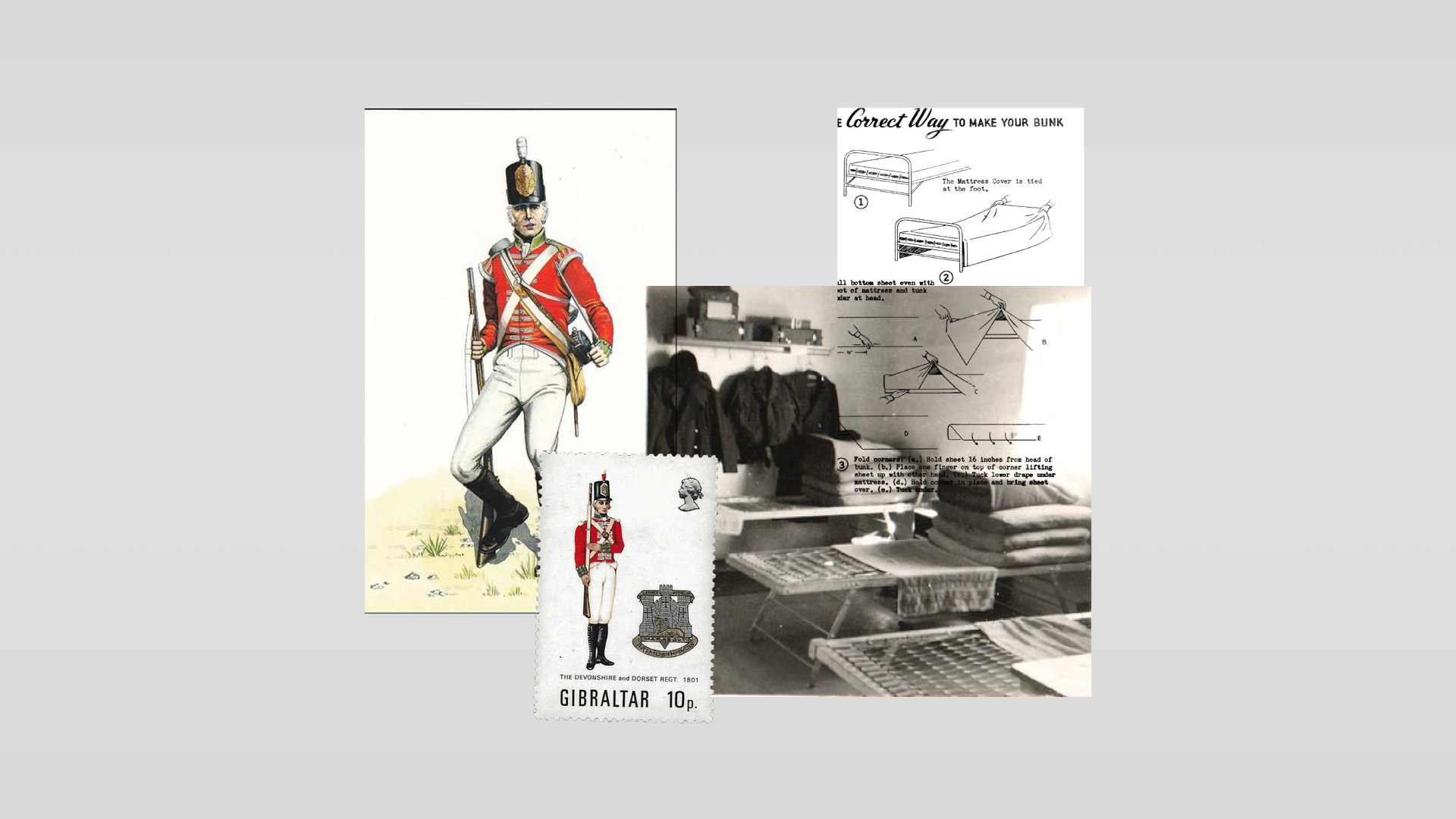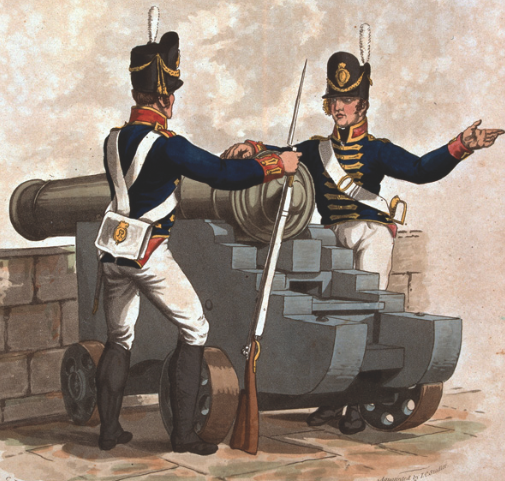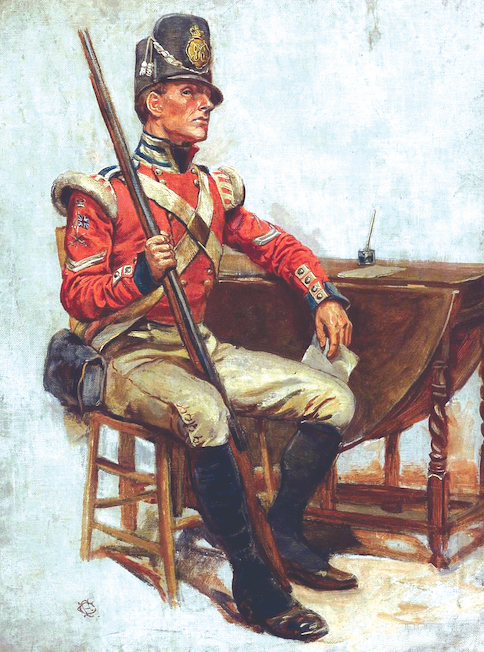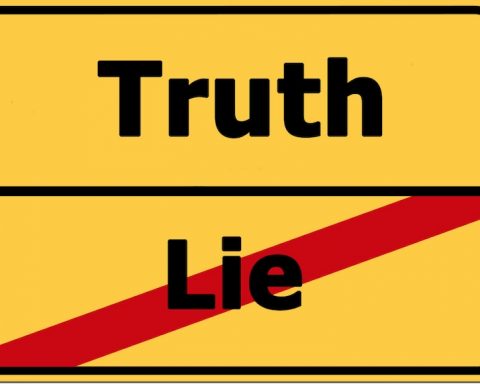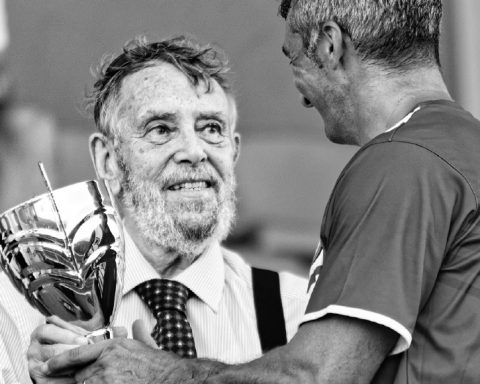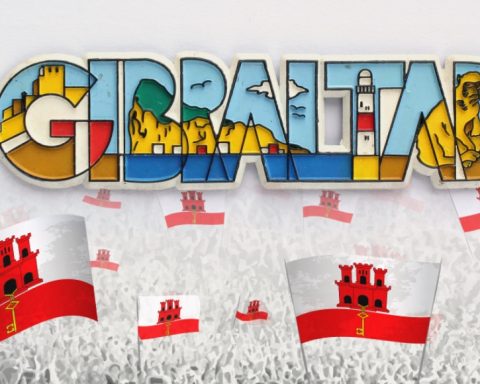Based on
“Standing Orders in the Garrison of Gibraltar 1803”
Most of us of a certain age will remember the ridiculous lengths to which we were made to go in preparing our beds, boots and equipment for inspection to please overzealous, tradition bound officers and NCO’s in the Gibraltar Defence Force, now The Royal Gibraltar Regiment. Many evenings were spent in burnishing our boot toecaps into mirrors and polishing our cap badges, buttons and brasses, only to be criticizes by some little napoleon for having a spot on the webbing, or a blanket not quite folded to the correct thickness.
But, if you think this was ridiculous give a thought to our predecessors in the same boat.
In the barracks, each room was approximately 18 x 36 feet and would accommodate nineteen man. Lack of space in some cases made it necessary to provide folding beds. In this area the men would also eat their meals and spend their off duty time when not in town.
Each man would be issued with a straw mattress, a box for his personal articles. Wooden tables, benches, a stove and wood would complete the barrack room. His personal uniform and accoutrements are listed below.
Following are some of the “Standing Orders“ in the Garrison of Gibraltar in 1803 during the Governorship of the Duke of Kent.
here is a list of items and how they are to be marked.
With the number of the battalion and regiment and numbered consecutively from 1 to 1000, or whatever the establishment may be. Thus: “1 Bn. 24th. Regt. 297.”
The hilts of swords and their scabbards:
Ditto.
Bayonets, Scabbards, Rammers, Nipple Wrenches, and Muzzle Stoppers:
Marked with consecutive numbers only. Marks on bayonet scabbard to be on button and not on the brass mouth-piece.
(All letters and numbers are to be ENGRAVED, and in no case punched or stamped on the arms (W.O. Cir. 582, 21st April 1860).
All articles of clothing
To be marked with the number and battalion of the regiment, and also the name and number of the wearer.
Tunic
Marked with white paint, inside across the middle of the back.
Trousers
With black paint on the waistband.
Boots and Shoes
Marked by a branding iron with the number of the regiment and the regimental number of the wearer; the former on the underside of the peak and the latter inside the upper leather.
Greatcoats
Marked inside the middle of the back with number or designation of regiment and also with the regimental number and name of the wearer marked with white paint.
All the following articles are to be marked with the number or appellation of the regiment, the owner’s name and number and the date of delivery, before it is issued from the quartermaster’s store:
Knapsacks
Regimental number in Arabic numerals, painted in white in the centre of the back. Number plates are to be furnished upon application.
linen and woollen articles
Marks written on them in indelible ink.
Knives, Forks, Spoons, Razors
Marks to be engraved.
Canteens and Squad Bags
Marked with paint. Cutting, punching or branding forbidden.
Belts, pouches and slings
Marked with number of regiment, battalion or corps and with date of issue on inside or back.
Blanket
Field service for men (rather than horses); grey; six foot 2 inches by 5 feet; weight, 3 lbs 12 ounces.
Accoutrements and appointments
Sgts. and Rank and File
• Pouches with swivel links
• Belts, pouch, complete
• Belts, waist
• Frogs, sliding, with buckles and straps
• Carbine slings
• Plates for waist belts
Greatcoats
For the Royal Artillery will be furnished at the public expense to all Non-commissioned Officers and Men. Coats for Sergeants shall be furnished without cuffs and Collars, which are to be added at the headquarters of each corps and shall be made of the same quality and colour of the facings of the corps. Chevrons on the right sleeve may be added at head quarters to the great coats of Sergeants and Corporals.
list of necessaries for the royal artillery
• 1 Canvas bag and hook
• 1 Canteen cover
• 2 Flannel shirts
• 1 Shaving bag
• 1 Forage cap
• 3 cotton shirts
• 1 Tin blacking
• 1 Large comb
• 1 Sponge
• 1 Pair boots
• 1 Pair leather gloves
• 1 Spoon
• 1 Pair Braces
• 1 Holdall
• 1 Stock
• 1 Knapsack complete
• 1 Clothes brush
• 1 Fatigue jacket
• 1 Shaving brush
• 1 Pocket knife
• 1 Great coat strap (pair)
• 2 Shoe brushes
• 1 Pillow case
• 1 Plume case
• 2 towels
• 1 Canteen
• 1 Razor and case
• 1 Pair fatigue trousers
• 1 Button stick
• 1 Button brush
• 3 Pairs woollen stockings
• 1 Hair brush
• 1 Knife and fork
• 1 Canteen strap
Kits will be furnished upon requisition addressed to the Secretary of State for War. They will be supplied complete, with the exception of the boots, fatigue jackets and trousers. The boots will be furnished in sizes. The fatigue jackets and trousers will be issued in materials, in order that they may be made up at the Depots and fitted to the recruit.
Because desertion was endemic, troops were not allowed to retain their civilian clothes which would make them stand out if they deserted, however in places like Gibraltar where troops outnumbered the civilian population, the opposite would be more likely.
Pay Scales
In order to get some idea of the money available to a soldier the following is provided based on 1861 pay scales and using a factor of 79 provided by the Bank of England.
A Sapper in the Royal Engineers would receive £22 per annum, which is approximately £4.76 per day less stoppages, a Corporal would get £40 which is £8.66 per day. A sergeant was on £52 which is equivalent to £11.25 per day.
A Lieutenant however earned £125 per annum which is £27.05, a Captain £330, or £71.42. The officers however were mostly recruited from well to do families and did not depend o their wages entirely, especially in view of the life style they were expected to maintain. Furthermore they were expected to supply their own uniforms. There were also many scams available to the officers to profit from purchasing uniforms and goods for the regiment. Even the Governors were not beyond making a profit form their position of power.
In civilian life, a labourer was expected to earn £35 or £7.50 per day.
In order to earn a pension, a soldier had to serve twenty one years and even with a perfectly clean record could only expect to receive £18.50 a year or £1461.50 in today’s money. Unless the veteran had a skill he would be force to seek charity to survive.
i
Officers usually wore their hair short and used a powdered wig, but the troops could not afford this luxury and wore their hair long.
iii
Powder was either flour or chalk. During the siege General Eliott forbid the use of flour for this purpose due to the shortage of food.
iii
Tallow was the usual grease used. This was usually the fat from mutton or beef.
iv
What happens when it rains? One can imagine the mess running down their faces during the parade.
v
In 1795, Parliament enacted a tax which required all those wishing to powder their hair to obtain a certificate from the Stamp Office at he cost of one guinea. There were some exceptions such as non commissioned officers and other ranks. Very few people complied and the act was repealed in 1869.
iv This is an 1860 standing order.

